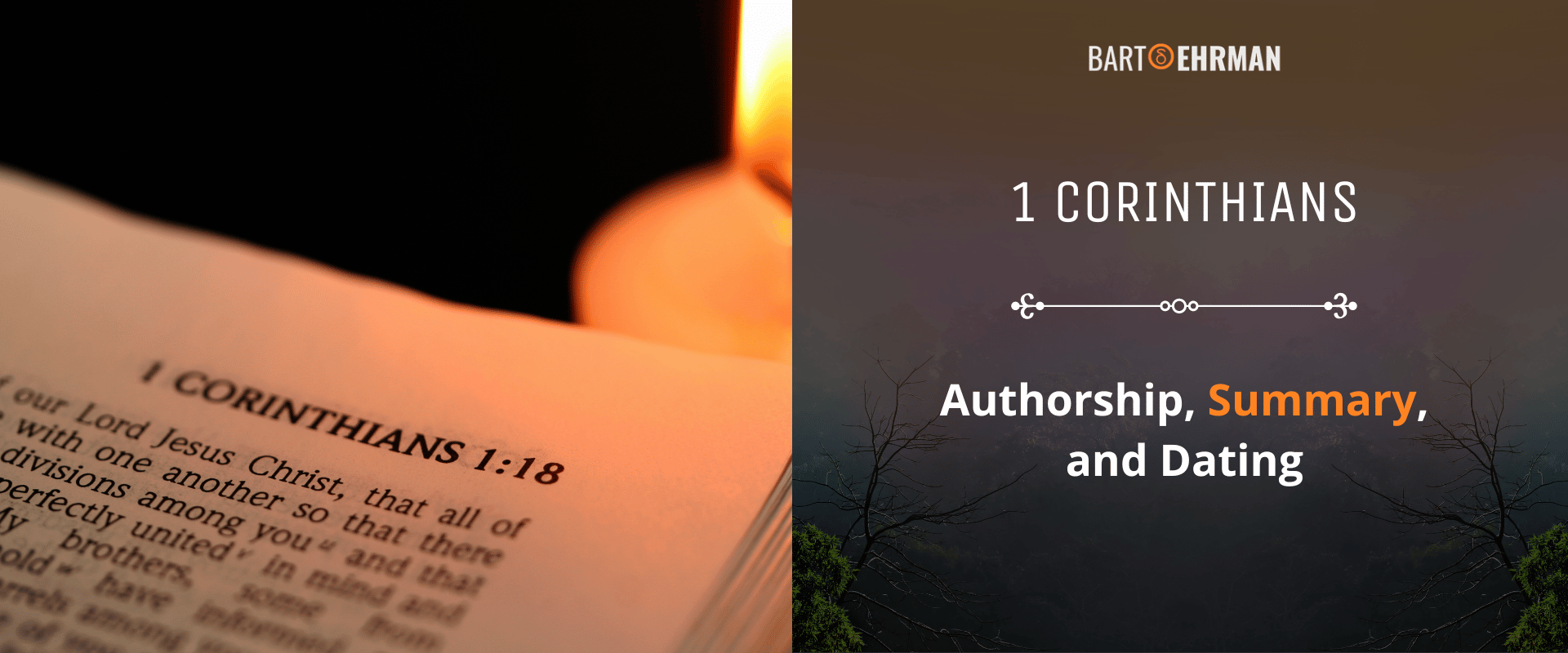exploring 1 Corinthians: Authorship, Summary, and Dating

Written by Marko Marina, Ph.D.
Author | Historian
Author | Historian | BE Contributor
Verified! See our guidelines
Verified! See our editorial guidelines
Date written: May 29th, 2024
Disclaimer: The views and opinions expressed in this article belong to the author and do not necessarily match my own. - Dr. Bart D. Ehrman
“Love is patient, love is kind. It does not envy, it does not boast, it’s not proud. It does not dishonor others, it is not self-seeking, it is not easily angered; it keeps no record of wrongs. Love does not delight in evil but rejoices with the truth.” These words from 1 Corinthians 13:4-6 are familiar to many as they are often heard in wedding ceremonies.
I have a little secret: At weddings, I love to bet my friends that the priest will read these verses, and I always win. Okay, almost always! Why? Because 1 Corinthians 13:4-6 is the go-to passage for any wedding officiant looking to add a timeless touch of love and wisdom.
Yet, these verses are part of a larger, deeply significant letter written nearly two millennia ago. Known as 1 Corinthians, this epistle addresses a variety of issues within the early Christian community in Corinth thus providing insight into the challenges and beliefs of early Christians.
While the Apostle Paul is traditionally credited with writing this letter, we’ll examine whether this attribution holds up under scholarly scrutiny. For convenience, we’ll refer to the author as Paul throughout this discussion.
Our exploration will cover four main areas:
By dissecting these elements, we can appreciate the cultural and historical significance of this epistle and its impact on the development of early Christianity.
Join us as we embark on this academic journey to better understand one of the New Testament's most important and frequently quoted letters.
Before we begin, consider this: Are you curious about the historical layers behind the New Testament Gospels and the origins of Christianity? Explore Bart D. Ehrman's exceptional course, “The Unknown Gospels”, where he scrutinizes their reliability and uncovers the myths and legends. Enroll now to deepen your understanding!

1 Corinthians: Historical Context and Summary
What is 1 Corinthians about? To answer this, we need to examine the broader historical context and understand why Paul wrote this letter in the first place.
The Christian community in Corinth, located in modern-day south-central Greece, was marked by significant division and conflict, largely due to the social and economic diversity among its members. Most members were Gentiles rather than Jews, but the differences in status and power led to serious problems and divisions within the congregation.
Gerd Theissen, in his study “The Social Setting of Pauline Christianity”, highlighted that these divisions were pronounced between wealthier and poorer members of the Corinthian church, leading to disputes over social status, conduct during communal meals, and the exercise of spiritual gifts. (Affiliate Disclaimer: We may earn commissions on products you purchase through this page at no additional cost to you. Thank you for supporting our site!)
Similarly, Bart D. Ehrman, in “The New Testament: A Historical Introduction”, notes that the Corinthian congregation faced numerous issues involving interpersonal conflicts and ethical improprieties.
He states: “The congregation that Paul addresses appears to have been riddled with problems involving interpersonal conflicts and ethical improprieties. His letter indicates that some of its members were at each other’s throats, claiming spiritual superiority over one another.”
Paul’s Response to the Social Crisis in Corinth
The major conflicts Paul tackles in his letter revolve around four issues: wisdom or spiritual insight, eating practices, spiritual gifts, and rhetorical eloquence.
He addresses these conflicts by emphasizing two powerful Christian symbols: the crucified Messiah and the body of Christ. According to Paul, these symbols indicate that believers in Jesus should find strength in weakness and unity in diversity.
In the first four chapters of 1 Corinthians, Paul describes the Corinthian believers as divided into factions based on their affiliation with different apostles. This division was partly due to basic group loyalty, where some people favored one leader over another, but it also stemmed from claims of superior wisdom about the faith by certain members of the community.
Chapters 8-10 highlight the differences in wealth and status, particularly regarding the problem of meat offered to pagan gods. Paul addresses whether it’s acceptable for Christians to eat meat left over from sacrifices to pagan gods.
Scholarly Insights: The Silence of Women in 1 Corinthians
One of the most debated passages in 1 Corinthians is found in 14:33-35, where Paul appears to instruct women to remain silent in churches. Scholars have long puzzled over these verses and some suggest they might not be Paul's words at all.
In their opinion, the evidence points to the later interpolation, as early manuscripts place these verses differently, and they seem to contradict Paul's acknowledgment of women praying and prophesying in 1 Corinthians 11:5. This mystery invites us to reconsider the dynamics of early Christian communities and the role of scribes in transmitting the Bible.
Among the Corinthian believers, opinions were split: some thought it was acceptable, while others didn’t. Paul emphasizes that the more important issue is not the meat itself, but the impact of such actions on the community's unity.
The communal meals themselves were another source of tension, as discussed in chapter 11. The Corinthian believers, like Christians elsewhere, met weekly to share the Lord’s Supper, which included bread and wine symbolizing the body and blood of Christ.
However, unlike most modern Christian practices, the Corinthians conducted this ritual as part of a regular dinner. This often resulted in the socially and economically privileged members getting better seats and more food and drink than the less privileged.
Paul viewed this competing for status and condescension toward fellow believers as incompatible with faith in Christ. He appealed to Christ’s example as a crucified Messiah who exemplified strength in weakness and unity in diversity.
He taught that just as believers make up the body of Christ, true unity requires diversity. This meant that behaviors causing division during communal meals were not merely impolite but an offense against the body of Christ.
In summary, Paul urged the Corinthian congregation to see itself as the body of the resurrected Jesus in the world. He emphasized that their practice of allowing some members to go hungry while others feasted was a significant affront to this unity.
He suggested two alternatives: Either wait for one another to ensure that everyone eats and drinks together, or hold separate meals and gather only for the Lord’s Supper. He reminded the Corinthians that they are one body with many members, each of which depends on the others, and made it clear that true fellowship in Jesus requires equality and mutual respect.
Up until this point, we have, for the sake of convenience, referred to the author as Paul. However, did Paul really write this letter? Let's now focus on who wrote 1 Corinthians by examining both internal evidence and external attestations.
Who Wrote 1 Corinthians? A Look at the Evidence
From the early years, the Church held that the apostle Paul wrote 1 Corinthians. This view has been long-standing within early Christian communities without any opposing views or doubts. It’s also supported by the explicit attribution in the letter itself: “Paul, called to be an apostle of Christ Jesus by the will of God” (1:1).
As it turns out, we have thirteen letters in the New Testament that claim to be written by Paul. However, scholars are confident that some of these letters were penned by later Christians who used Paul’s name to lend authority to their writings. This practice, known as pseudepigraphy and widely condemned in the ancient world, raises the question: Is 1 Corinthians among genuine Pauline letters, or is it a later forgery?
Several strong arguments support the Pauline authorship of 1 Corinthians, leading virtually all scholars to include it among the undisputed letters of Paul.
a) Internal Evidence
As noted, the author explicitly identifies himself as the apostle Paul. In their highly acclaimed Commentary, Roy E. Ciampa and Bryan S. Rosner explain: “In identifying himself Paul draws attention to the fact that he is an apostle, an agent or messenger of Christ Jesus. This assertion appears in all of Paul’s epistolary prescripts except for 1 and 2 Thessalonians, Philippians, and Philemon. In 1 Corinthians, as in Galatians, it functions to bolster his standing in a community where at least some were questioning his authority.”
Moreover, the letter’s style, vocabulary, and theological themes are consistent with other undisputed letters of Paul, such as Romans and Galatians. In other words, how Paul addresses the issues within the Corinthian church, his rhetorical techniques, and personal references align closely with what is known of Paul’s other writings.
Regarding theology, 1 Corinthians aligns closely with Paul’s known beliefs. Themes such as the centrality of Jesus’ crucifixion and resurrection, the importance of faith for salvation, and the ethical implications of living as a Christian in a pagan society are all known Pauline topics.
They aren’t only consistent with Paul’s theology but are also developed in ways that echo his other letters. For instance, Paul’s discourse on spiritual gifts and the body of Jesus in 1 Corinthians 12-14 parallels his discussions in Romans 12.
In his Commentary, Joseph Fitzmyer reveals an interesting parallel while analyzing Paul’s usage of charisma in 1 Cor 12:4. He notes: “In Romans 12:6, Paul plays on the similarity of charisma to charis (“grace”), words which are etymologically only remotely related, to stress how charismata denote specific participation of individuals in God's grace.”
Furthermore, Paul's letters often contain personal remarks and references that lend authenticity to his correspondence. In 1 Corinthians, Paul mentions his earlier visit to Corinth and expresses his intention to return thus mirroring the personal touch found in other undisputed Pauline letters.
Finally, the style of writing is Pauline. Hans Conzelmann asserts in his Commentary: “The epistle displays the well-known characteristics of the language of Paul. Elements of the higher Koine stand side by side with elements of colloquial speech. On average, we have (elevated) Koine combined with elements of the LXX (Greek translation of the Bible).”
b) External Attestation
Early Christian writers almost universally refer to 1 Corinthians as an authentic letter of Paul. To my knowledge, there was never a dispute among the early Church about this issue. Take, for instance, Clement of Rome (c. 96 C.E.) who in a letter addressed to Corinthian Christians, not only quoted or alluded to passages in Paul’s 1 Corinthians (1 Clem. 37.5; 49.5) but also ascribed this letter to “the blessed Paul, the Apostle” (47.1).
Furthermore, In the late 2nd century, the bishop of Lyon Irenaeus also referenced 1 Corinthians in his work "Against Heresies”. He utilized Paul’s writings extensively to counter various heretical teachings. In some cases, he cites explicitly 1 Corinthians to argue for doctrinal purity and the apostolic tradition.
Additionally, the inclusion of 1 Corinthians in every canonical list (e.g. the Muratorian Fragment, c. 170 C.E.) further underscores its acceptance as a genuine work of Paul. Even the “heretic” Marcion accepted Paul’s letter to the Corinthians in his canon. This early canonical recognition from “both sides” of the early Christian world reflects the broad consensus and shreds to pieces any serious doubts about the authorship of 1 Corinthians.
Finally, the textual tradition of 1 Corinthians is secure and sound. Joseph Fitzmyer observes: “It’s remarkable how uniformly the Greek text of 1 Corinthians as a whole has been transmitted in the various text traditions. It’s found in the usual threefold text traditions of the Pauline corpus: a) The Alexandrian; b) The Western, and c) the Byzantine.”
In his Commentary on 1 Corinthians, William Baker concludes: “The opening words of 1:1 name Paul as the author of 1 Corinthians, and his authorship has never been seriously questioned. In the annals of critical inquiry, 1 Corinthians joins Romans, 2 Corinthians, Galatians, Philippians, and 1–2 Thessalonians as one of the major epistles that form the core of Paul’s writings, and by which the vocabulary, style, and theology of the rest are measured for authenticity.”
Having established the strong evidence for the Pauline authorship of 1 Corinthians, we now turn our focus to another crucial aspect: the date of its composition. Understanding when this letter was written is key to grasping its historical context and its impact on the early Christian community.

When Was 1 Corinthians Written? Dating Paul’s Epistle
Dating Paul’s undisputed letters typically involves examining both internal and external evidence. Scholars analyze historical references within the letters, cross-referencing these with known historical events and figures.
Additionally, they consider external attestations and contextual clues from other ancient texts, such as Acts of the Apostles, to pinpoint a more precise timeline. By aligning these pieces of evidence, scholars can construct a plausible chronology for Paul’s epistles.
Even in ancient times, there was suspicion that Paul might have written other letters to the Corinthians, and it was unclear whether their content had been incorporated into the canonical texts as we have them today. This historical ambiguity complicates the process of dating 1 Corinthians, especially if we consider the possibility of later redactions.
However, unlike some other Pauline letters, 1 Corinthians offers some potential help from other sources, particularly the Acts of the Apostles. The value of this information, of course, hinges on the extent to which Acts is regarded as a reliable historical source.
Acts 18 provides critical details that help date Paul’s time in Corinth. According to Acts, Paul arrived in Corinth after the expulsion of the Jews from Rome by Emperor Claudius while Gallio was the proconsul of Achaia. In his book “Early Christianity”, Gerd Ludemann notes that most scholars hold that this expulsion occurred around 41 C.E.
Paul likely arrived in Corinth shortly after this event, joining Aquila and Priscilla, who were among those expelled from Rome. Acts 18:11 mentions that Paul remained in Corinth for 18 months which suggests a significant period of ministry there.
Given this timeline, 1 Corinthians must have been written after Paul's stay in Corinth. Furthermore, we must account for the time that elapsed after Paul left Corinth. He traveled to Jerusalem, returned to Asia Minor, and eventually rejoined Aquila and Priscilla in Ephesus.
This sequence of movements suggests that there was a gap between his departure from Corinth and the writing of the letter. So, when was 1 Corinthians written?
Based on this historical framework, the majority of scholars agree that Paul wrote 1 Corinthians between 54 and 56 C.E. This dating is supported by the convergence of internal evidence from the letter itself and external historical markers.
Summing up Conclusion
As we reflect on the familiar words from 1 Corinthians 13, often heard at weddings, we gain a deeper appreciation for their origins and the context in which they were written. These verses aren’t merely poetic expressions of love but part of a powerful message addressed to the Christian community in Corinth that experienced serious social problems from within.
Through our careful examination, we have explored the historical context of 1 Corinthians which helped us understand the social and economic diversity that led to significant divisions and conflicts among the Corinthian believers.
Furthermore, we have analyzed the strong evidence supporting the traditional view that the Apostle Paul authored this letter, noting both internal consistency with his other writings and external attestations from early Christian leaders.
Finally, we have traced the likely timeline of its composition, situating it within the broader narrative of Paul’s missionary journeys around 54-56 C.E. The most probable conclusion is that the apostle wrote 1 Corinthians around the time he was stationed in Ephesus.
By dissecting these elements, we not only appreciate the cultural and historical significance of 1 Corinthians but also recognize its impact on the development of early Christianity. Undoubtedly, this letter remains one of the most important documents that shaped the course of early Christianity in numerous ways.
